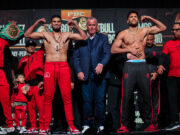By Norm Fruenheim-

It’s been a year full of lots of things.
Full of it, perhaps, if 2017 will be remembered for the spectacle-over-substance display of Floyd Mayweather Jr. entering the ring in a bandit’s mask for his money grab against Conor McGregor.
That single, most-watched event over the last 12 months was embarrassing for the obscene hype it generated and the gullibility it exposed in the four-plus million pay-per-view customers who paid for the show.
The guess here is that it will be forgotten and never be repeated, although the latter might be hoping for too much.
If it wasn’t exactly a great year, it was a promising one because of Terence Crawford, Vasiliy Lomachenko, Mikey Garcia, Errol Spence, Gennady Golovkin, Canelo Alvarez and the ongoing move away from the pay-per-view business model.
The promise was played out in one terrific fight — Anthony Joshua climbing off the deck for an 11th-round stoppage of Wladimir Klitschko on April 29 in London. It’s Fight of the Year, of course.
There are other nominees, but none are contenders in a 2017 that will forever be known for a fight significant on so many levels.
There was the crowd at London’s Wembley Stadium — 90,000, boxing’s biggest since World War II. It was a classic between heavyweights, a division that had begun to look as old as the newsreel footage of WW II battles.
But there it was, all over again and available on live stream, with the kind of drama that plays well in any era. It was timeless. Klitschko gets up from a fifth-round knockdown. Joshua gets up in the sixth, clearly hurt and yet survives. Klitschko is down again, twice in he eleventh and back on his feet after both before a succession of Joshua punches forces a stoppage.
It was a classic reminder of how good the heavyweights have been and can still be. As we await 2018’s opening bell, there is relevance and some of the aforementioned promise in all of that. Decades and a piece of Evander Holyfield’s ear have come and gone since anybody talked about the heavyweights.
But on the list of fights that fans want to see, Joshua-versus-American Deontay Wilder is right there, alongside Garcia-Lomachenko, a Golovkin-Canelo rematch and Crawford against any of the top-ranked welterweights.
Will it happen? Hard to say. At the negotiating table, Joshua’s popularity among UK fans is as powerful as Canelo’s ability to draw Mexican fans.
A sure sign of that came in a follow-up. In October, a crowd of 78,000 showed up in Cardiff, Wales, for Joshua’s victory over Carlos Takam, who had none of Klitschko’s name recognition.
Joshua has yet to create much of a following in the U.S. If an overrated Ricky Hatton proved anything, however, it’s that UK fans travel. In New York or Las Vegas, he’d be the crowd favorite against Wilder.
First, however, it looks as if a couple of things have to happen. There are ongoing negotiations for Joshua to fight Joseph Parker of New Zealand, perhaps in March. There are also talks for Wilder to finally face Cuban Luis Ortiz, also in March.
Of the two, Wilder faces the biggest danger. The clever Ortiz has enough skill to beat Wilder. It depends on which Ortiz shows up. Wilder’s fundamental skillset has always been questioned. But he has always won, mostly with a right as good as any in many years.
If Wilder’s right hand instead of Klitschko’s had knocked down Joshua in April, the guess here is that the Wembley fight would have ended then and there.
But it has to land, and there’s a question about whether Wilder can do that against Joshua, a 2012 Olympic gold medalist. It’s also a question that includes wilder’s right-handed power, a so-called equalizer as unpredictable as it is dynamic.
As a New Year begins, it’s a talking point, a reason for optimism that wouldn’t be there if not for Joshua-Klitschko, Fight of the Year and the best heavyweight fight in at least a generation.






















